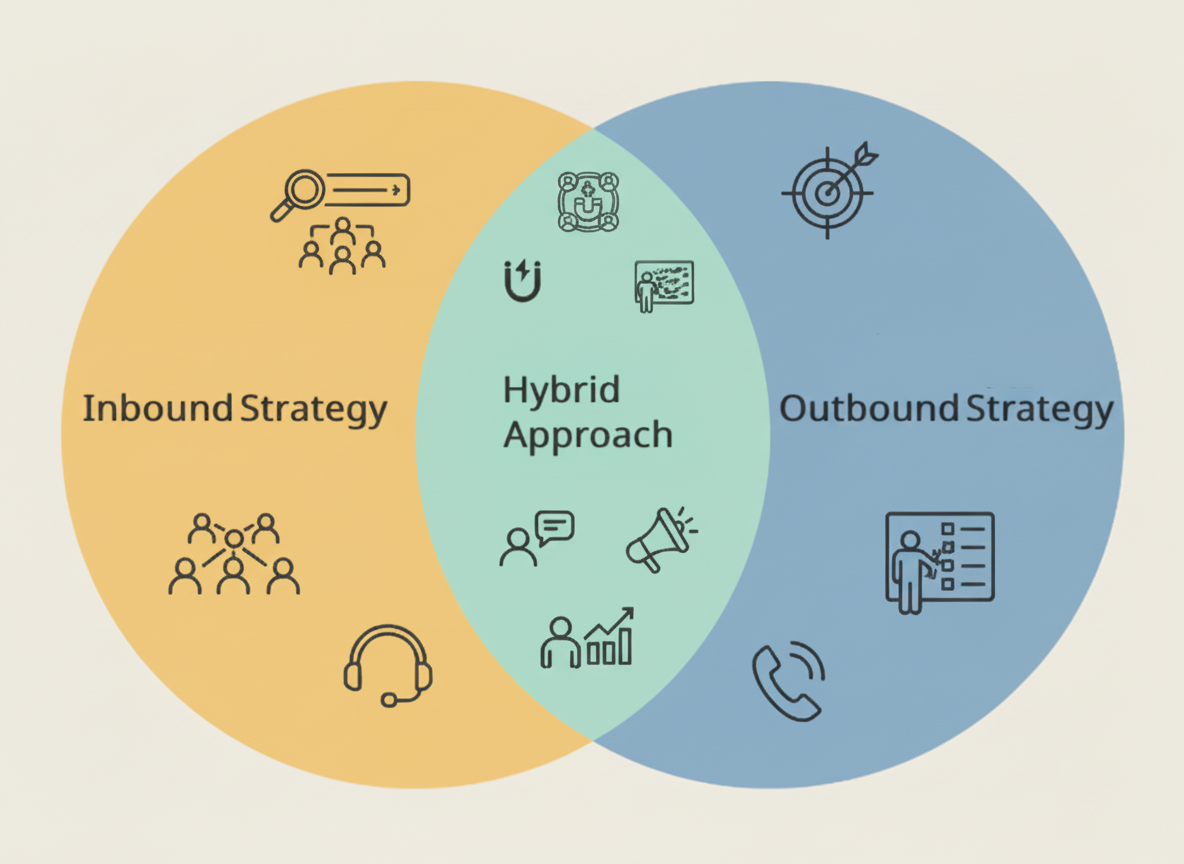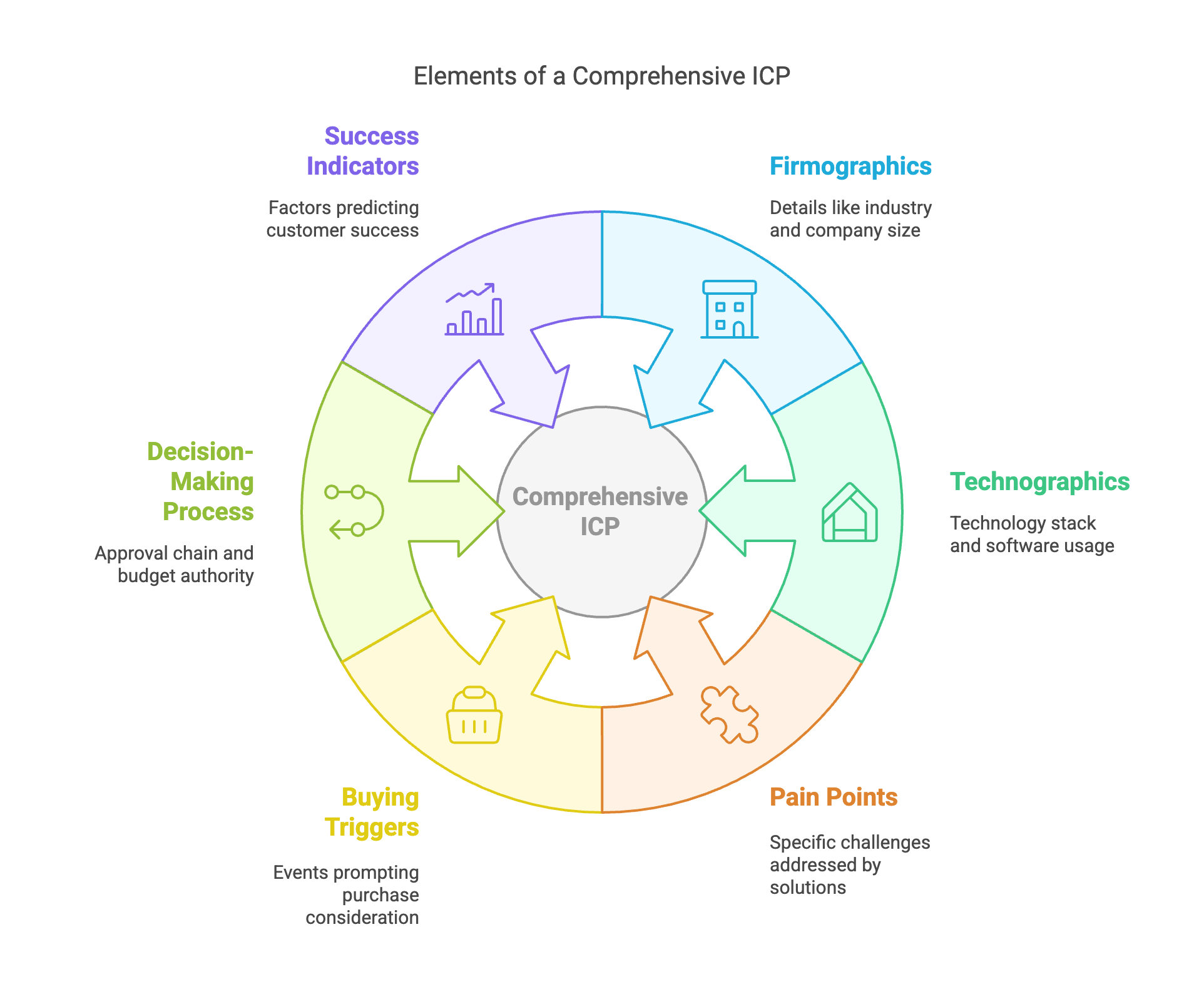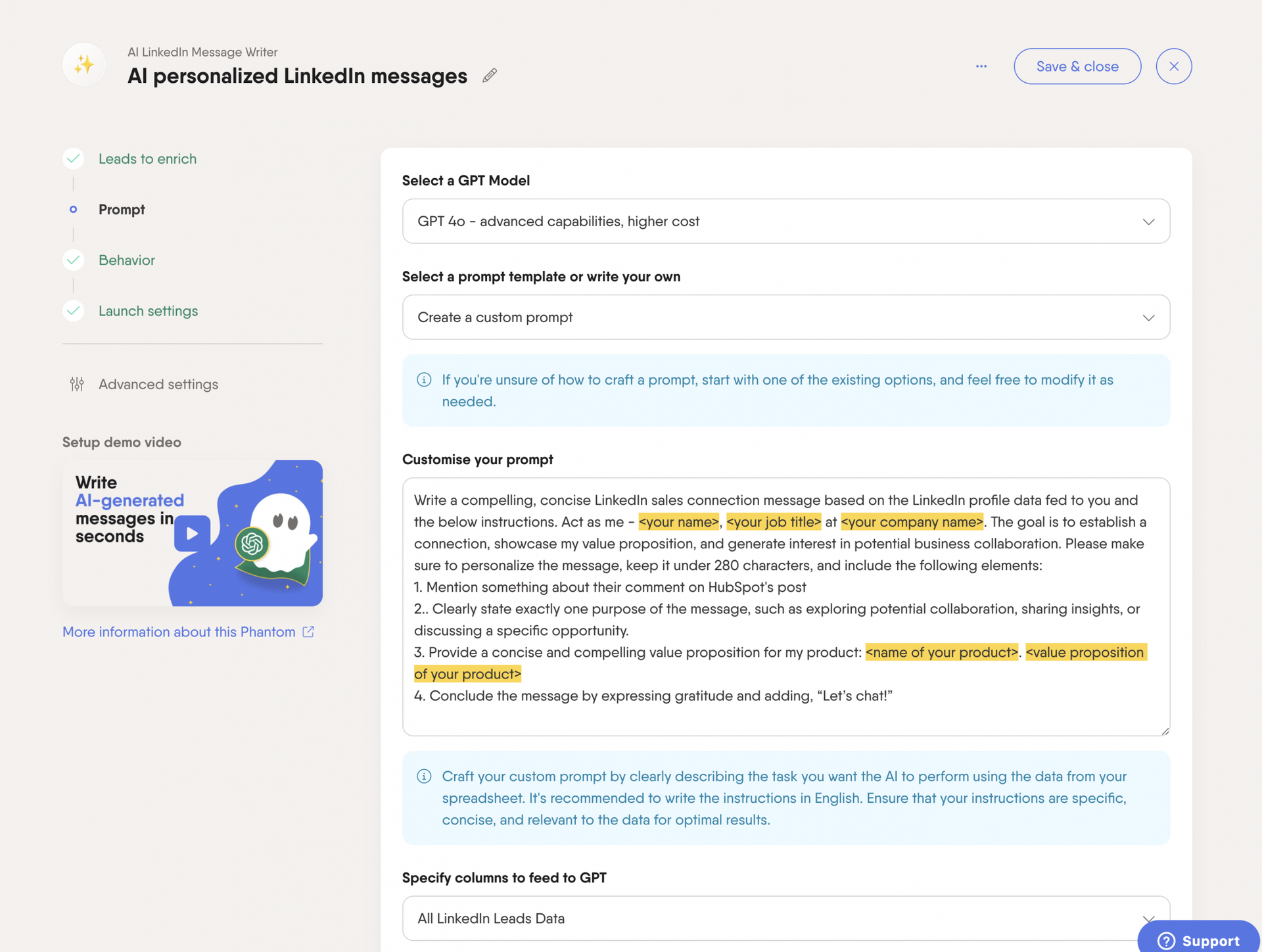Here’s what most guides won’t tell you: The best sales teams don’t choose between inbound and outbound sales. They use both. The challenge isn’t picking the right approach, it’s coordinating both effectively without burning out from manual work.
You’ll get better results by running inbound and outbound together.
Automate research, enrichment, and first-touch outreach with PhantomBuster automations so you spend more time on calls and less on prep. We’ll show you how to run inbound and outbound in one workflow, avoid common pitfalls, and use PhantomBuster to scale lead generation, without losing the human touch.
Inbound vs outbound sales: key differences to plan your 2025 mix
Understanding the fundamental differences between inbound and outbound sales helps you choose the right approach for specific situations and prospects.
| Factor | Inbound Sales | Outbound Sales | |
|---|---|---|---|
| Contact initiation | Prospect contacts you first | You reach out first to target accounts | |
| Lead quality | Higher intent, pre-qualified interest | Variable, requires qualification | |
| Time to results | Often takes months to compound—track leading indicators (traffic, form fills, demo requests) weekly and review at 90-day intervals | Can generate meetings within days when targeting active buying triggers (new funding, hiring spikes, tech changes) | |
| Cost per lead | Lower long-term cost. Content and SEO can lower cost per opportunity over time once pages rank and convert—expect front-loaded content investment | Data, tools, and rep time are front-loaded; minimize waste by narrowing ICP and using enriched, verified lists | |
| Skills required | Consultative selling, content knowledge | Prospecting, cold outreach, persistence | |
| Common challenges | Inconsistent lead flow, longer cycles | Low response rates, rejection handling | |
| Best for | Complex solutions, education-heavy sales | Urgent timeline, specific target accounts |
Use both. Match your approach to ICP, deal size, and timeline, then connect the data so each channel informs the other.
What is inbound sales (and why it’s not as passive as you think)
Inbound sales is a sales approach where prospective customers initiate contact with your company after discovering your brand through content, search engines, referrals, or other marketing efforts. These inbound customers have shown some level of interest before reaching out, making them typically higher-intent prospects than cold outbound contacts.
But here’s a critical misconception: inbound sales isn’t passive.
While inbound prospects start the conversation, you must actively qualify, educate, and guide these potential customers through the sales process. The inbound sales process requires just as much skill and effort as outbound selling, it’s simply focused on nurturing existing interest rather than creating it from scratch.
Key characteristics of inbound sales
- Prospects arrive with defined pain points and awareness of their problems
- You educate with concrete proof (demos, case studies, ROI calculators)
- You follow up on specific triggers (visited pricing page, clicked case study, attended webinar)
- You qualify on budget, timing, and fit rather than creating urgency from scratch
Inbound sales examples
- LinkedIn content engagement leading to connection requests
- Webinar attendees booking follow-up meetings—trigger a 2-line follow-up referencing the session topic
- Website visitors requesting product demos—route demo requests to a prioritized queue and enrich before the call so you open with relevant context
- Prospects downloading whitepapers or case studies—trigger a follow-up referencing the asset they downloaded
- Referrals from existing customers
Automation Tip: Use PhantomBuster’s LinkedIn Profile Scraper automation to append public role, company size, and socials to inbound leads, then route records to your CRM. This helps you prepare for more meaningful conversations and identify the best prospects.
What is outbound sales (and why it’s not just cold calling)
Outbound sales is a sales strategy where you proactively reach out to potential customers who may not be familiar with your company or actively looking for your solution. Your outbound sales team initiates contact through various channels to generate interest and move prospects into the sales funnel.
Many sales professionals mistakenly think outbound sales means only cold calling. Start with two channels your buyers use most (often LinkedIn and email). Add warm intros when you have mutuals.
The key is reaching the right prospective customers with personalized messages that demonstrate value and relevance.
Here’s a concrete example: Pair a funding alert with a 3-step sequence—LinkedIn view, personalized email referencing the round, and a short call script tied to the hiring plan.
Key characteristics of outbound sales
- You reach out first to target accounts
- Requires extensive prospect research and personalization
- Get fast replies that confirm message-market fit; adjust copy within days
- More control over pipeline generation and timing
- Scale safely by batching 20–50 targeted touches per day within platform limits
Outbound sales examples
- Personalized LinkedIn messages referencing recent company news
- Email campaigns triggered by specific events or job changes
- Social selling through thoughtful engagement on prospects’ content
- Targeted phone calls to decision-makers in specific industries
- Direct outreach to attendees at industry events
Automation Tip: Use PhantomBuster’s LinkedIn Company Scraper automation to collect public company details (size, industry, recent posts), then push fields to your CRM to personalize first-touch messages. Always follow LinkedIn’s terms and local privacy laws.
Why the “inbound vs outbound” debate misses the point in 2025
The traditional inbound vs outbound sales debate assumes you must choose one approach and stick with it. Choosing one channel caps your pipeline, running both widens reach and improves win rates.
Buyers bounce between channels before booking a demo. They research solutions across multiple channels, consume content from various sources, and expect personalized interactions throughout the customer journey, regardless of how they first discovered your company.
A buyer might read your blog post, attend a competitor’s webinar, and receive your cold email. Then they book a demo through your sales funnel before making a purchase decision.
Market realities that demand hybrid strategies:
- Increased Competition: Your prospects get lots of pitches. Lead with a trigger they care about (new role, product launch) and a one-line value hook. Standing out requires multiple touchpoints across different channels to build familiarity and trust.
- Urgent Timing: If timing is urgent, use outbound to surface a specific quick win (e.g., cut data entry by 30%) and offer a 15-minute call. Sometimes direct outbound outreach is necessary to capture attention when prospects are ready to buy.
- Complex Decision-Making: B2B purchases involve multiple stakeholders with different preferences for how they want to be contacted. Some prefer educational content, others respond better to direct outreach.
- Platform Saturation: Popular channels become crowded quickly. Use lower-friction touches first (profile view, short comment), then send a tight, value-led note. LinkedIn InMail boxes are flooded, email inboxes are overwhelmed, and content marketing faces increasing competition for attention.
- Top teams run inbound and outbound together, then automate prep with PhantomBuster so reps spend more time selling.
The hybrid approach: How to combine inbound and outbound effectively
Building an effective hybrid sales strategy requires careful coordination between inbound and outbound sales efforts.
Instead of treating them as separate activities, successful sales teams create integrated systems where both approaches reinforce each other.

Step 1: Start with your ideal customer profile
Your ideal customer profile (ICP) serves as the foundation for both inbound marketing content and targeting prospective customers for outbound sales. Without a clear ICP, your inbound efforts will attract the wrong prospects, and your outbound sales team will waste time on unqualified leads.
Define your target customers based on:
- Company size and revenue
- Industry and business model
- Technology stack and tools used
- Growth stage and funding status
- Geographic location and market presence
- Common pain points and challenges
Use your ICP to pick topics for inbound and build tight outbound lists of lookalike accounts.

Use this ICP question list to define firmographics, pain points, and triggers.
Automation Tip: Use PhantomBuster’s LinkedIn Profile Visitor and AI Enricher together to collect public role, skills, and company info for lookalike accounts, then sync to your CRM as “ICP fit” fields for targeting.
Step 2: Build your inbound foundation
Effective inbound sales strategies start with creating valuable content that attracts your ideal prospects and establishes your expertise. Focus on addressing the specific challenges your target audience faces rather than promoting your product directly.
Essential inbound components grouped into three pillars:
- Attract (SEO posts): Educational blog content addressing prospect pain points. Track organic traffic and time-on-page.
- Capture (high-intent CTAs): Lead capture mechanisms on high-traffic pages. Measure form completion rate.
- Nurture (email + webinar): Email sequences for different prospect types and webinars showcasing your expertise. Track open rates and demo bookings.
The goal is to create an inbound sales machine that consistently attracts qualified leads and nurtures them through educational content until they’re ready for sales conversations. Use this step-by-step inbound setup checklist for topics, CTAs, and lead capture.
Step 3: Layer in strategic outbound outreach
While building your inbound foundation, launch targeted outbound sales campaigns to reach prospects who haven’t discovered your content yet but fit your ideal customer profile. Use your inbound marketing content as conversation starters and social proof in outbound messages.
Strategic outbound targeting:
- Companies that match your ICP but haven’t engaged with your content
- Prospects at target accounts who aren’t active on social media
- Decision-makers who typically don’t consume online content
- Time-sensitive opportunities where waiting for inbound isn’t practical
The key to successful outbound selling is thorough research and genuine personalization. Generic sales pitches get ignored, but relevant messages that demonstrate understanding of the prospect’s specific situation get responses.
Start with a 50-account pilot. Build a 3-step sequence:
- Pull a list with LinkedIn Search Export
- Enrich with AI Enricher
- Send a 3-line email referencing a recent trigger and one quantified outcome
Measure reply rate and booked calls in two weeks.
Automation Tip: Use PhantomBuster’s HubSpot Contact Data Enricher automation to append available public LinkedIn fields to existing HubSpot contacts when you provide a LinkedIn URL. This enables your outbound sales team to send highly relevant messages that stand out in crowded inboxes.
Step 4: Create feedback loops between both approaches
The most powerful hybrid strategies use insights from outbound sales conversations to improve inbound marketing efforts, while leveraging inbound engagement data to identify warm prospects for outbound outreach.
Inbound to outbound feedback:
- Use content engagement data to identify prospects showing buying signals
- Leverage webinar attendees and content downloaders for targeted follow-up
- Track which topics generate the most inbound interest for outbound conversation starters
Outbound to inbound feedback:
- Share common objections with marketing teams to create addressing content
- Identify content gaps based on prospect questions during sales calls
- Use successful outbound messaging to inform inbound marketing campaigns
Review monthly which inbound topics drive the most replies and reuse those angles in outbound.
Common mistakes that kill hybrid sales strategies (and how to avoid them)
Even sales teams with good intentions often struggle with hybrid approaches because they make fundamental mistakes that undermine their efforts. Here are the most common pitfalls and how to avoid them.
Mistake 1: Treating inbound and outbound as separate activities
Many sales organizations create silos between inbound sales representatives and outbound sales teams, leading to duplicate efforts, inconsistent messaging, and missed opportunities for coordination.
The problem: Prospects receive conflicting messages from different team members, data isn’t shared between teams, and opportunities fall through cracks during handoffs.
The solution:
- Sync PhantomBuster outputs to your CRM with the native bi-directional integration.
- Log profile visits, enrichments, and messages under the same account to avoid duplicate outreach.
- Establish shared messaging frameworks and implement regular communication between inbound and outbound sales reps working the same accounts.
Mistake 2: Not personalizing outbound outreach
Generic outbound sales efforts get ignored. Sales representatives who send templated messages without researching their prospects waste time and damage their company’s reputation.
The problem: Low response rates, poor brand perception, and frustrated sales professionals who blame outbound sales for being “broken” when the real issue is a lack of personalization.
The solution: Invest time in thorough prospect research, reference specific details about the prospect’s company or recent activities, and connect your outreach to genuine value rather than generic sales pitches. Use PhantomBuster to pull one public fact per prospect and add it as a “hook” token in your template before sending.
Automation Tip: Use PhantomBuster’s AI LinkedIn Message Writer automation to draft a short, specific connection note. Keep one personalization hook, and always review before sending.

Mistake 3: Giving up on inbound too quickly
Inbound sales strategies require consistent effort over months before generating significant results. Many sales teams abandon inbound marketing efforts too early when they don’t see immediate lead flow.
The problem: Inconsistent content creation, unrealistic expectations for quick results, and switching between strategies before giving them time to work.
The solution: Commit to consistent content creation for at least six months, measure leading indicators like website traffic and content engagement rather than just lead volume, and supplement inbound efforts with outbound sales while building momentum.
Mistake 4: Over-automating without human touch
Automation tools make hybrid sales strategies possible, but over-automation creates robotic interactions that damage relationships and hurt conversion rates.
The problem: Prospects feel like they’re talking to robots, automated sequences don’t adapt to individual responses, and personal relationships suffer from a lack of genuine human interaction.
The solution: Use automation for research, data collection, and initial outreach, but ensure all follow-up conversations are genuinely human. Train sales teams to use automation insights for better personalization rather than replacing human judgment.
FAQ
Which approach should new sales reps start with?
Start with outbound sales to learn sales fundamentals and get immediate feedback on your sales skills, then layer in inbound strategies as you develop expertise. Outbound selling teaches you essential skills like handling objections, qualifying prospects quickly, and adapting your sales pitch in real-time. These sales fundamentals are valuable regardless of whether prospects come from inbound or outbound sources.
However, don’t wait until you’ve “mastered” outbound sales before starting inbound efforts. Begin creating valuable content and building your professional brand early, as inbound marketing efforts take time to generate results. The combination of immediate outbound results and long-term inbound building creates the strongest foundation for your sales career.
How long does it take to see results from inbound sales?
Plan for months to compound. Review leading indicators biweekly and adjust topics and CTAs based on conversion data. However, you can see faster results by optimizing existing inbound sources like website forms, referral programs, and social media engagement.
The timeline depends on your target audience, competition level, and consistency of your inbound marketing efforts. B2B sales with long sales cycles typically take longer to show results than transactional B2C sales. Focus on leading indicators like website traffic, content engagement, and social media followers during the early months while building momentum.
Is outbound sales harder than inbound?
Outbound works when you target a clear trigger and personalize one line. Tools help you find the trigger and prep the message fast. The key is proper research, genuine personalization, and using multiple channels rather than relying solely on phone calls.
Outbound selling challenges include lower initial response rates, more rejection, and the need for consistent prospecting activity. However, outbound sales gives you more control over your pipeline, faster feedback on your sales approach, and the ability to target specific accounts strategically. Many sales professionals find outbound more rewarding because of the direct impact their efforts have on results.
How do I know if a prospect is better for inbound or outbound approach?
Active researchers and content consumers typically respond well to inbound nurturing and educational approaches. These prospects prefer to control their buying journey and make decisions based on thorough research and comparison, which is aligned with an inbound sales approach.
Busy executives, decision-makers with urgent needs, or people in roles where they don’t typically consume marketing content may require direct outbound outreach to capture their attention. Time-sensitive opportunities also benefit from proactive outbound sales efforts rather than waiting for prospects to find you through inbound channels.
Use both: if someone engaged with your content but didn’t book, send a short, relevant follow-up referencing that topic.
What’s the biggest mistake beginners make with sales approaches?
The biggest mistake is thinking you have to choose between inbound vs outbound sales and master one completely before trying the other. This all-or-nothing thinking limits your sales potential and creates unnecessary pressure to pick the “right” strategy.
The most successful sales professionals start simple with both approaches and improve over time. They understand that inbound and outbound sales strategies complement each other rather than compete. They also recognize that automation tools can remove the manual barriers that make coordinating both approaches difficult for beginners.
Start with basic outbound prospecting to learn sales fundamentals while beginning to create content and build your professional brand for long-term inbound success.
How much should I automate my sales process?
Automate the preparation work, research, data collection, initial outreach, and follow-up scheduling, but keep actual sales conversations genuinely human and personalized. A good rule of thumb: automate everything that happens before and after prospect conversations, but ensure the conversations themselves are authentic and responsive to individual prospect needs.
Respect platform limits and privacy. Only automate actions that comply with LinkedIn and local regulations, and keep reps in the loop for final sends.
Over-automation hurts sales results when prospects feel like they’re interacting with robots rather than real people. Under-automation wastes time on repetitive tasks that could be handled by sales tools, leaving less time for high-value activities like relationship building and strategic account development.
The goal is to use automation to become a more effective sales representative, not to replace human judgment and relationship-building skills that drive successful sales outcomes.
